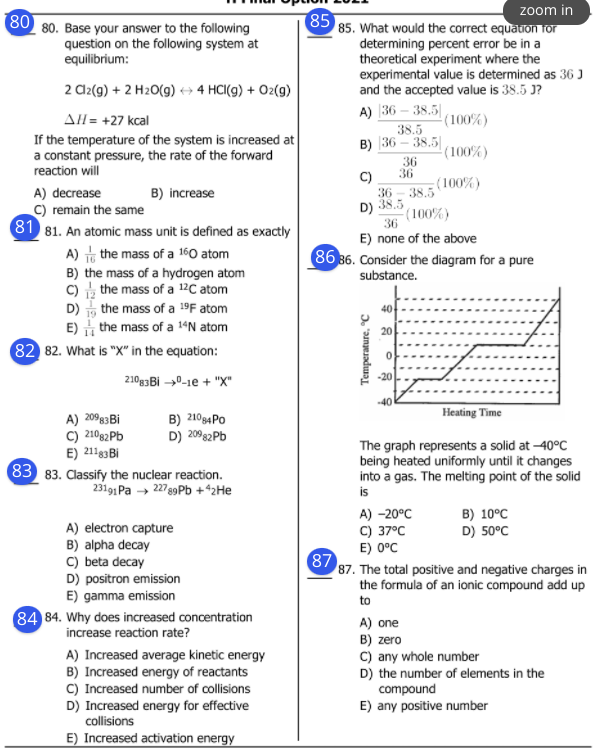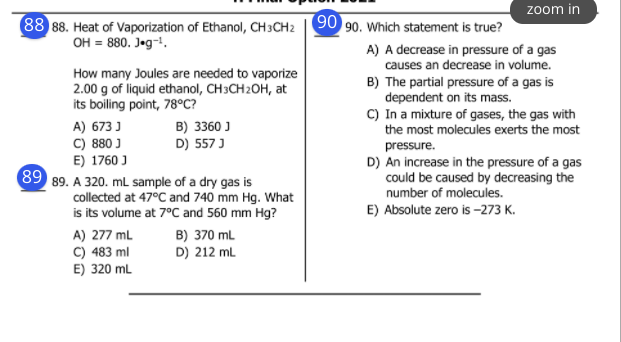80. Base your answer to the following question on the following system at equilibrium: 2 dz(g) + 2 H20(g) → 4 HCI(g) + Oz(g) AH= +27 kcal If the temperature of the system is increased at a constant pressure, the rate of the forward reaction will A) decrease B) increase C) remain the same
80. Base your answer to the following question on the following system at equilibrium: 2 dz(g) + 2 H20(g) → 4 HCI(g) + Oz(g) AH= +27 kcal If the temperature of the system is increased at a constant pressure, the rate of the forward reaction will A) decrease B) increase C) remain the same
Introductory Chemistry: A Foundation
9th Edition
ISBN:9781337399425
Author:Steven S. Zumdahl, Donald J. DeCoste
Publisher:Steven S. Zumdahl, Donald J. DeCoste
Chapter13: Gases
Section: Chapter Questions
Problem 140AP: he following demonstration takes place in a two-step process: rst, solid calcium carbide...
Related questions
Question
HELP PLEASE if someone or anyone could help on any of these questions you will literally be my life saver.

Transcribed Image Text:zoom in
85
80 80. Base your answer to the following
question on the following system at
equilibrium:
85. What would the correct equaton for
determining percent error be in a
theoretical experiment where the
experimental value is determined as 36 J
and the accepted value is 38.5 J?
2 az(g) + 2 H2O(g) + 4 HCI(g) + Oz(g)
A) 36 – 38.5
(100%)
All = +27 kcal
If the temperature of the system is increased at
a constant pressure, the rate of the forward
reaction will
38.5
B) 36 - 38.5|
(100%)
C)
36
36
36
(100%)
A) decrease
B) increase
38.5
C) remain the same
D) 38.5
(100%)
36
81 81. An atomic mass unit is defined as exactly
E) none of the above
A) t the mass of a 160 atom
B) the mass of a hydrogen atom
C) the mass of a 12C atom
D) 5 the mass of a 19F atom
E) i the mass of a 14N atom
86 36. Consider the diagram for a pure
substance.
40
20
82 82. What is "X" in the equation:
-20
21083Bİ 0-1e + "X"
Heating Time
A) 20983Bİ
C) 21082PD
E) 21183BI
B) 21094PO
D) 20982PD
83 83. Classify the nuclear reaction.
23191 Pa → 227 g9Pb +42HE
The graph represents a solid at -40°C
being heated uniformly until it changes
into a gas. The melting point of the solid
is
A) -20°C
C) 37°C
E) 0°C
B) 10°C
D) 50°C
A) electron capture
B) alpha decay
C) beta decay
D) positron emission
E) gamma emission
87
87. The total positive and negative charges in
the formula of an ionic compound add up
to
84 84. Why does increased concentration
increase reaction rate?
A) Increased average kinetic energy
B) Increased energy of reactants
C) Increased number of collisions
D) Increased energy for effective
collisions
A) one
B) zero
C) any whole number
D) the number of elements in the
compound
E) any positive number
E) Increased activation energy
Temperature, °C

Transcribed Image Text:zoom in
88 88. Heat of Vaporization of Ethanol, CH3CH2 90 90. Which statement is true?
OH = 880. J«g¬.
A) A decrease in pressure of a gas
causes an decrease in volume.
How many Joules are needed to vaporize
2.00 g of liquid ethanol, CH3CH2OH, at
its boiling point, 78°C?
B) The partial pressure of a gas is
dependent on its mass.
C) In a mixture of gases, the gas with
the most molecules exerts the most
B) 3360 J
D) 557 J
A) 673 J
C) 880 J
E) 1760 J
89 89. A 320. mL sample of a dry gas is
pressure.
D) An increase in the pressure of a gas
could be caused by decreasing the
number of molecules.
collected at 47°C and 740 mm Hg. What
is its volume at 7°C and 560 mm Hg?
E) Absolute zero is -273 K.
A) 277 mL
C) 483 ml
E) 320 mL
B) 370 ml
D) 212 mL
Expert Solution
This question has been solved!
Explore an expertly crafted, step-by-step solution for a thorough understanding of key concepts.
Step by step
Solved in 3 steps

Knowledge Booster
Learn more about
Need a deep-dive on the concept behind this application? Look no further. Learn more about this topic, chemistry and related others by exploring similar questions and additional content below.Recommended textbooks for you

Introductory Chemistry: A Foundation
Chemistry
ISBN:
9781337399425
Author:
Steven S. Zumdahl, Donald J. DeCoste
Publisher:
Cengage Learning


Chemistry: Principles and Reactions
Chemistry
ISBN:
9781305079373
Author:
William L. Masterton, Cecile N. Hurley
Publisher:
Cengage Learning

Introductory Chemistry: A Foundation
Chemistry
ISBN:
9781337399425
Author:
Steven S. Zumdahl, Donald J. DeCoste
Publisher:
Cengage Learning


Chemistry: Principles and Reactions
Chemistry
ISBN:
9781305079373
Author:
William L. Masterton, Cecile N. Hurley
Publisher:
Cengage Learning

Chemistry & Chemical Reactivity
Chemistry
ISBN:
9781133949640
Author:
John C. Kotz, Paul M. Treichel, John Townsend, David Treichel
Publisher:
Cengage Learning

Chemistry & Chemical Reactivity
Chemistry
ISBN:
9781337399074
Author:
John C. Kotz, Paul M. Treichel, John Townsend, David Treichel
Publisher:
Cengage Learning

General Chemistry - Standalone book (MindTap Cour…
Chemistry
ISBN:
9781305580343
Author:
Steven D. Gammon, Ebbing, Darrell Ebbing, Steven D., Darrell; Gammon, Darrell Ebbing; Steven D. Gammon, Darrell D.; Gammon, Ebbing; Steven D. Gammon; Darrell
Publisher:
Cengage Learning